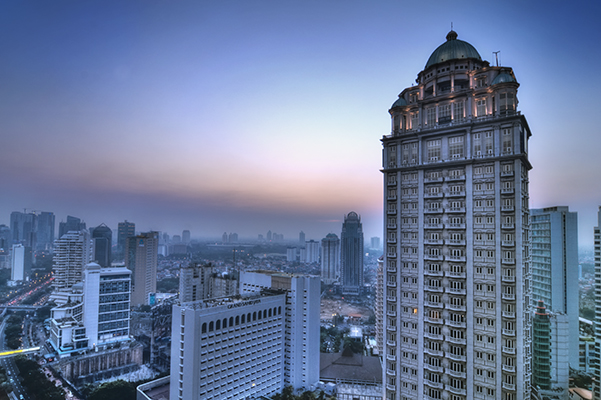
What is Jakarta?
— Indonesia Lonely Planet (1997)Jakarta is all Indonesia rolled into one huge urban sprawl of nearly nine million people. Indonesians come from all over the archipelago to seek fame and fortune, or just to eke out a living. Bataks and Minangkabau from Sumatra, Ambonese from Maluku, Dani from Irian Jaya, Minahasans from Sulawesi, Balinese, Madurese and Timorese are all united by Bahasa Indonesia and a desire to make it in the capital. For it is in Jakarta that the latest styles and thoughts are formed, the important political decisions are made. Jakarta is the main centre for the economy, a place to find work, do deals and court government officials.
— South-East Asia on a Shoestring Lonely Planet (2001)Indonesia's capital is a congested sprawl of wealth and poverty, modernity and tradition, attracting Indonesians from all over the archipelago in search of a better life. The hopeful keep coming, despite the economic downturn and increased poverty.
Jakarta is a hard city to love. One of the world's greatest metropolises , its grey, relentlessly urban sprawl spreads for tens of kilometers across a flood-prone plain with barely a park to break the concrete monotony.
— Indonesia Lonely Planet (2010)And yet beneath the unappealing facade of high-rises, slums and gridlocked streets, this is a city of surprises and many faces.
— Introducing Jakarta LonelyPlanet.com (2017)It's weird that Jakarta seemed like a more optimistic place during Suharto's New Order regime. Were travel writers ignoring the poverty, plummeting economy, and rising political instability of the time? Since then the city has been steadily improving, by some metrics. We're in the process of building our first MRT, and expanding the TransJakarta bus system too. But it's also getting worse—just look at the traffic, rising intolerance, and increasing sprawl. All those stickers on the back of trucks might be onto something… maybe it was better back in the day.One of the world's greatest megalopolises, Jakarta is a dynamic city of daunting extremes with surreal juxtapositions on every street corner.
Photo by Axel Drainville
Jakarta is always transforming
Over the last decade or so, Jakarta has undergone a huge transformation. Once, it's miserable poverty and crumbling infrastructure made it one of the hell holes of Asian travel. Now, the city's face is being changed by the constant construction of more skyscrapers, flyovers, hotels and shopping malls.
The showpiece of the prosperous new Jakarta is the central business district bounded by Jl Thamrin/Sudirman, Jl Rasuna Said, and JL Gatot Subroto. The 'Golden Triangle,' as it known, is crammed with office towers, luxury hotels and foreign embassies. Viewed from here, Jakarta has all the appearances of a prosperous Asian boom city.
Some parts of the city still bear the scars of the riots that brought down Soeharto. Following the shooting of four students by the military on 12 May 1998, the urban poor went on a shocking rampage of rioting and looting that left over 1000 people dead.
— South-East Asia on a Shoestring Lonely Planet (2001)Life in Jakarta has returned much to normal, though the city is now the political cauldron for a democratic Indonesia. The freeways, office towers, luxury hotels and shopping centres of the good times remain, but the empty building sites and flyovers going nowhere are a testament to Indonesia's uncertain future.
— Indonesia Lonely Planet (2010)Though Jakarta's infamous traffic jams still choke the city, an ever-expanding modern busway network has speeded up travel considerably in recent years.
— Introducing Jakarta LonelyPlanet.com (2017)An organism unto itself, Jakarta is a town in the midst of a very public metamorphosis and, despite the maddening traffic, life here is lived at an all-out pace, driven by an industriousness and optimism that's palpable. Dysfunction be damned. It's developing at a pace that throws up challenges. Translation: it's no oil painting, yet beneath the unappealing facade of new build high-rises, relentless concrete and gridlocked streets, fringed with rickety slums and shrouded in a persistent blanket of smog, Jakarta has many faces and plenty of surprises.
Photo by Tommy Wahyu Utomo/ Flickr CC License
Our nightlife isn't as fun as it once was
— Indonesia Lonely Planet (1997)Jakarta is the most sophisticated , broad-minded and corrupt city in Indonesia, and has nightlife to match. Hundreds of bars, discos, karaoke lounges and nightclubs range from the sleazy to the refined.
— South-East Asia on a Shoestring Lonely Planet (2001)Jakarta is the most sophisticated , broad-minded, and corrupt city in Indonesia, and has nightlife to match. And despite the economic downturn and protests by religious fanatics, the city's nightlife still rages.
Jakarta is Indonesia's most broad-minded, sophisticated and decadent city, with the nightlife to match. The club scene is nothing short of incendiary.
— Indonesia Lonely Planet (2010)It's pretty surprising that a travel guide somehow captured the rise of the FPI. Way back in Suharto's New Order, the hardline group didn't even exist. A few years later, some "religious fanatics" had started to appear. By 2010, the group was mentioned BY NAME as a potential danger for partying tourists. It makes me wonder what next year's edition is going to say.Occasionally, bars and clubs have been smashed up by the city's self-appointed morality police, the Jakarta-based Front Pembela islam (FPI or Islamic Defenders Front), especially during Ramadan.
Photo by Seika/ Flickr CC License
The rise and fall of Jl Jaksa
— Indonesia Lonely Planet (1997)Once upon a time, so the story goes, a backpacker arrived at Jakarta's Gambir train station and wandered off looking for a hotel, without success. He chanced down Jl Jaksa and a family took pity on him and gave him a bed for the night. The word spread and soon other backpackers started arriving at the house, so the family decided to open a hostel. Other guesthouses followed and now Jl Jaksa is a lively strip of cheap hotels and restaurants, conveniently central near Jakarta's main drag, Jl Thamrin and only a 10 to 15 minute walk from Gambir train station.
— South-East Asia on a Shoestring Lonely Planet (2001)Jakarta's cheap accommodation is almost all centered on Jl Jaksa.
— Indonesia Lonely Planet (2010)Jl Jaksa has fallen on some hard times. It's always been pretty rundown, but in recent years a lot of the bars and guesthouses vanished after the construction of a luxury apartment tower ate about half the block. As the apartment tower went up, the reggae bars came down. So it's so long to the dive bar greats like Obama Fan Club and Absolute and hello to bland Padang restaurants and dead ass streets.I was never a fan of the street, but it's a bit weird that nearly every other Southeast Asian capital has a thriving backpacker district and today we have… nothing.This is the traveller's ghetto in Jakarta, but today it's a shadow of its former gap-year glory and looking pretty rundown. The handful of remaining budget places are looking grungy, but the area does have some decent midrange options and plenty of restaurants and bars.
